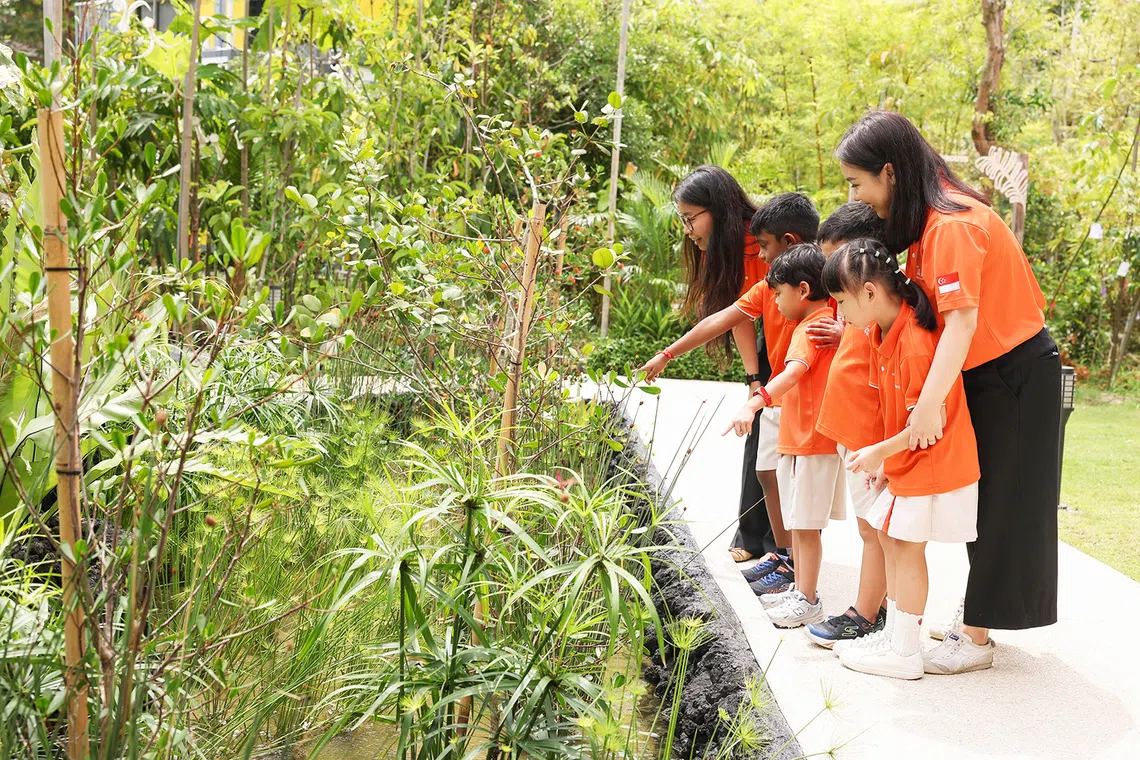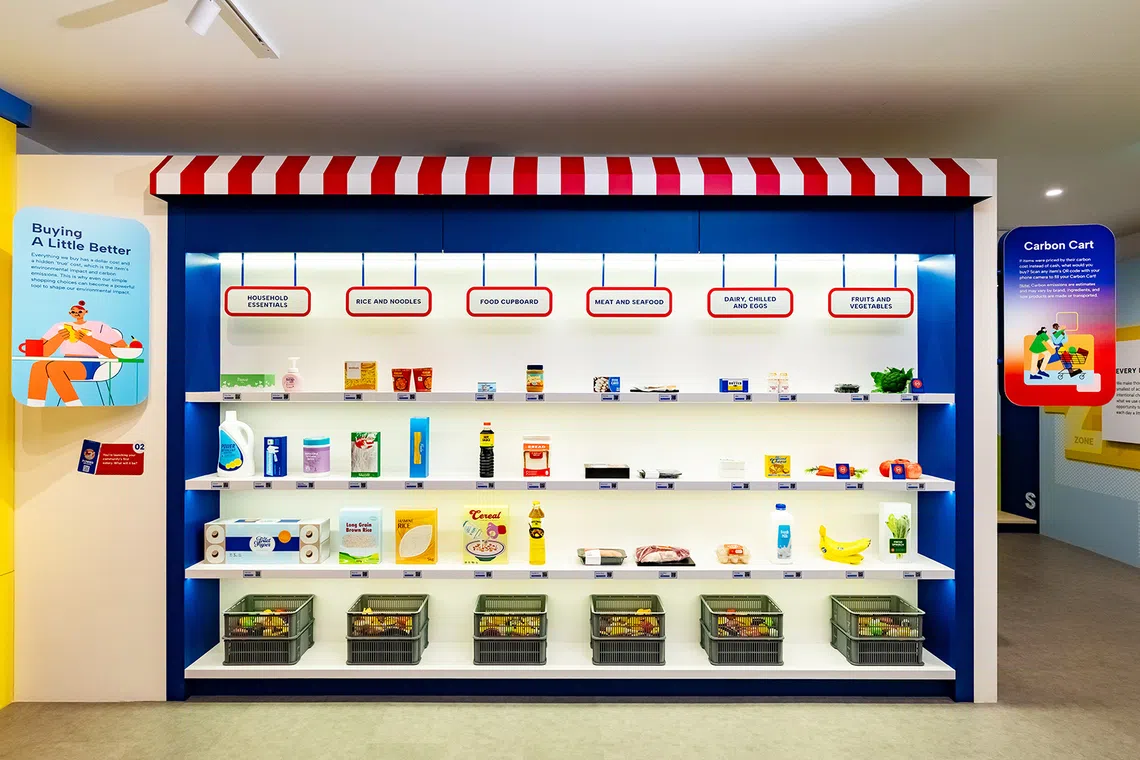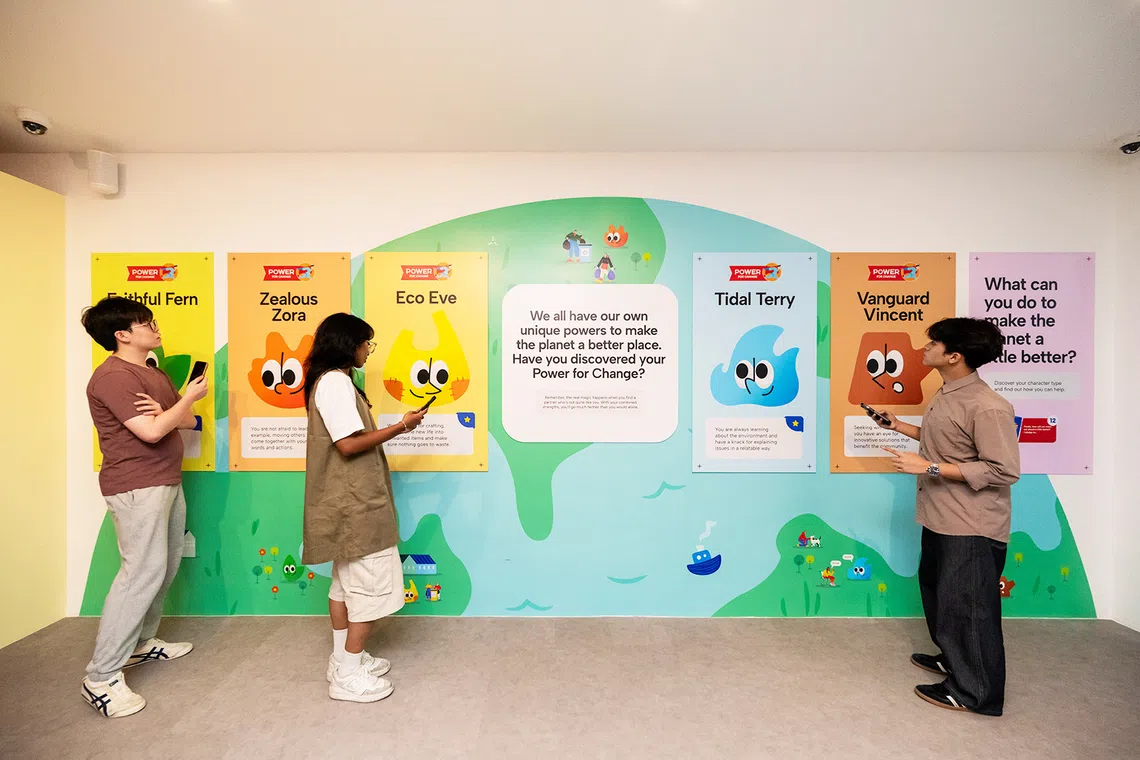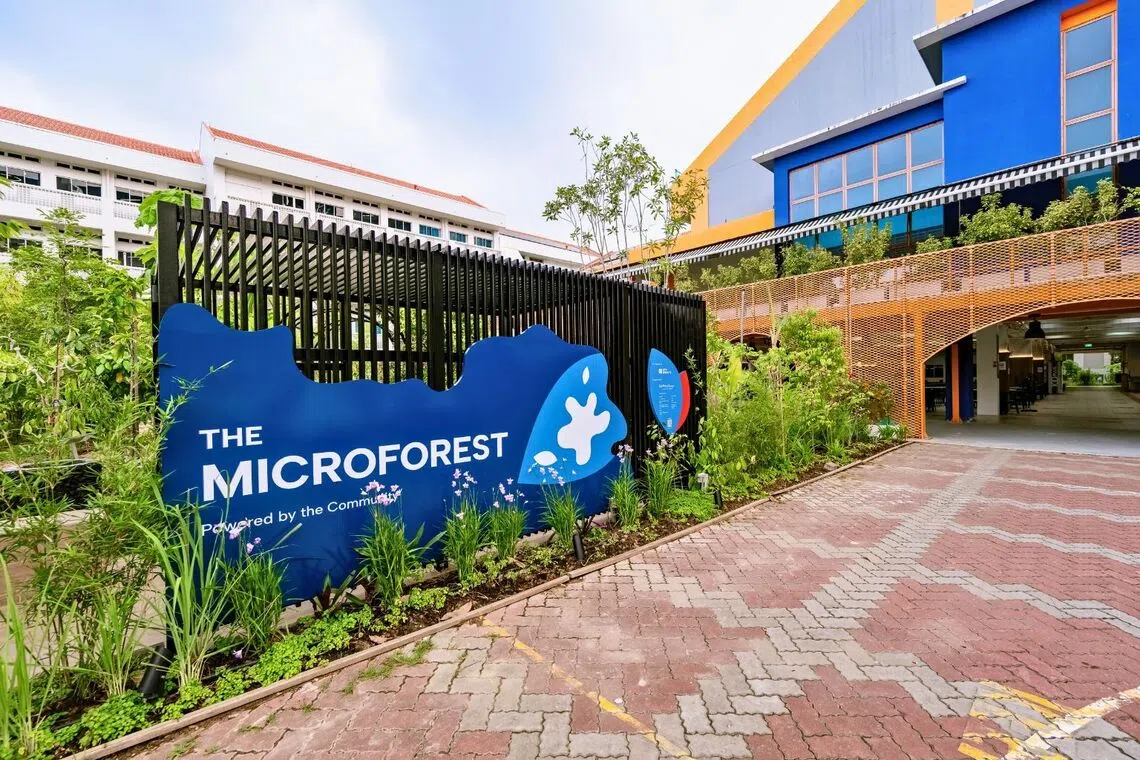Branded content
From groceries to air-con: Find out how much CO2 your lifestyle really produces
The Carbon Gallery uses immersive, multi-sensorial exhibits, games and videos to make it fun and easy to see how your daily lifestyle affects climate change

At The Carbon Gallery, climate action comes alive through exhibits that reveal how daily choices impact the planet.
PHOTO: FAIRPRICE GROUP
Follow topic:
Tan Ying Hua may be only six years old but climate change is already on her mind.
“We need to make sure that the temperature in the world will not get too hot in the future. If it gets too hot, we might faint,” says the Kindergarten 2 student at My First Skool earnestly.
Ying Hua was inspired to do her part for the planet after she visited The Carbon Gallery
“When I see some rubbish on the floor, I will help my mummy clear it and I will tell others that littering is wrong. Every night, I make sure that the lights at home are switched off before I sleep. I upcycle things like plastic bottles and change them into a flower pot!”

Preschoolers from My First Skool explore the lush greenery at The Carbon Gallery, which introduces young learners to biodiversity.
PHOTO: FAIRPRICE GROUP
Through the gallery, Asia’s first carbon-focused experiential hub, FairPrice Foundation hopes to make carbon literacy, awareness and education fun and relatable for all ages. It does this with immersive and interactive elements that revolve around easy-to-understand concepts like shopping, eating and commuting.
The gallery complements the Singapore secondary school geography curriculum and supports primary school sustainability and environmental learning, bridging classroom knowledge on the complex relationship between human and environmental systems with interactive, real-world experiences and examples.

Multi-sensorial exhibits turn abstract sustainability concepts into hands-on lessons for all ages.
PHOTO: FAIRPRICE GROUP
Ying Hua’s favourite activity is The Carbon Cart, where she uses “carbon coins” to shop for daily essentials. This supermarket-inspired concept challenges what you know about grocery shopping. At a typical supermarket, you may pay for your favourite cereals, shampoo and fresh vegetables with cash or a tap of your phone or card. But at The Carbon Cart, you get to “shop” for these with no more than 60 carbon coins.
For instance, a head of broccoli costs two coins, a packet of cheese goes for 31 coins and a slab of beef sets you back 60 coins. What are carbon coins? Think of them as mock money that illustrates the carbon cost of each item, which is correlated to its estimated carbon emission. Locally grown greens generally have the lowest carbon footprint and imported beef scores the highest. So, the more conscious you are of how you spend, the better it is for the planet.

The Carbon Cart exhibit challenges visitors to “shop” using carbon coins, revealing the hidden carbon cost behind everyday essentials.
PHOTO: FAIRPRICE GROUP
Learning that lasts
Mr Danny Wong, a school teacher at My First Skool, says that the hands-on activities that mirror real-life experiences made his preschoolers curious about sustainable living and think about how they can take care of the environment.
“They learnt about not wasting food and many of them became more mindful of their daily actions, and some even reminded adults to turn off the lights and air-conditioning when leaving the room,” he says.
It is not just kindergarteners who find the gallery interesting. Upper secondary geography teacher Sarifah Tamsir also recalls how intrigued her students were to see abstract concepts like carbon footprints and net-zero targets that they had learnt about in class come to life.
After their field trip, she noticed many of them becoming more conscious of their daily habits, with some even starting their own recycling drives.

Visitors answer questions at checkpoints throughout The Carbon Gallery and later discover which “Power for Change” character best represents their sustainability persona.
PHOTO: FAIRPRICE GROUP
“The visit sparked meaningful conversations about personal responsibility and environmental action. When students see real-world applications of what they learn, they feel a stronger sense of agency to contribute to sustainability efforts,” says Ms Sarifah.
Open to the public for free, The Carbon Gallery was initiated and developed by sustainability social enterprise Terra SG and supported by the FairPrice Foundation, the philanthropic arm of FairPrice Group and the gallery’s founding partner.
The gallery’s learning environment reflects the history of its premises, which previously housed the former Loyang Primary School, now known as Vidacity.

The Microforest, part of The Carbon Gallery’s outdoor learning spaces, features native plants that naturally cool and purify the air by absorbing carbon.
PHOTO: FAIRPRICE GROUP
By end 2025, it expects to welcome 28,000 visitors, mostly students from primary and secondary schools. It is part of a series of initiatives (see box) by FairPrice Group and FairPrice Foundation to foster community engagement in Singapore’s heartlands and encourage habits that are kinder to the environment.
“We want to make carbon literacy fun, engaging and most importantly, easy for all in Singapore to understand – that’s our vision for The Carbon Gallery. If there’s one thing I hope visitors take away, it’s that anyone, no matter how old or young, can take small everyday steps that ladder up to make things easier on the planet for the next generation,” shares Ms Jean Khong, general manager of FairPrice Foundation.
Mr Kelvin Wong, co-founder of Terra SG, shares that after running sustainability programmes in schools and communities for years, his team found that many know about climate change but not how their daily actions are linked to carbon.
The Carbon Gallery is a chance to show them the link between carbon emissions, climate change and daily lifestyles. “Visitors can see, touch and make choices that show how everyday actions impact the planet,” says Mr Wong.

The Respite Garden offers a tranquil space for the public to reflect on their role in protecting the planet.
PHOTO: FAIRPRICE GROUP
Kendra Moo, a secondary two student, likes how The Carbon Gallery takes her out of the classroom.
“In school, we mostly learn through textbooks and discussions. At the gallery, the experience was more hands-on and visual. I could see how my choices affect the planet, and this made the topic more real and personal, not just something to study for exams,” she shares.
An exhibit that left the greatest impression on her was ‘Every Day, A Little Better’ in Zone 2, where visitors can scan RFID discs on a sensor to watch and learn how everyday waste like glass bottles and even egg shells can be upcycled into quirky lamps and floor tiles.

Visitors can learn about waste and recycling at an interactive exhibit that highlights how everyday items can be given a second life.
PHOTO: FAIRPRICE GROUP
There are also interesting facts displayed all over this zone, engaging visitors to rethink their commuting habits and make their homes more sustainable by doing things as simple as setting one’s air-conditioner at 25 deg C and also using fans to circulate the air more efficiently.
Kendra says she is taking a more conscious effort to turn off lights and fans when she leaves a room and to use reusable shopping bags. “We are the generation that will live with the long-term effects of climate change, so it’s up to us to act now,” she says.
Food for thought
In 2024, FairPrice Foundation refreshed its community engagement pillars to remain relevant and responsive to society’s evolving needs. It laid out three strategic priorities of uplifting communities through nutrition and access to daily essentials, strengthening community welfare and engagement, and supporting workers’ welfare.
Through supporting and funding The Carbon Gallery, it hopes to build a more sustainable future for generations to come. Some of the other initiatives by FairPrice Group and FairPrice Foundation include:
Neighbourhood Food Share: An established food rescue programme that benefits more than 25,000 individuals every year by distributing more than two tonnes of rescued fruits and vegetables monthly.
Imperfect Fellas: Shoppers are encouraged to buy blemished but perfectly edible fresh fruits and vegetables to cut down on food wastage.
Community Bag Rack: Customers can pick up reusable bags for free or place theirs for the next person to use.
FairPrice City Square Mall: This was relaunched last August as the group’s most sustainable supermarket with a projected 30 per cent lower carbon footprint compared to the average FairPrice supermarket in Singapore.
See your carbon footprint in action by planning a visit to The Carbon Gallery today.
Vidacity, 3A Pasir Ris Drive 6, #01-32/33, Singapore 519422
Mondays to Sundays: 9am to 5pm (Closed 12.30pm to 1.30pm for lunch)
Eve of public holidays: 9am to 1pm • Closed on public holidays
Subject to changes in 2026


